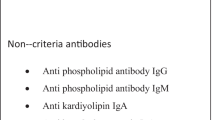Abstract
The objective of the present study was to analyse the performance of the tests for detection of anti-β2 glycoprotein I (β2 GP I) and anticardiolipin (aCL) antibodies for identification of clinical manifestations of the antiphospholipid syndrome (APS). Patients with systemic lupus erythematosus (SLE) as well as carriers of infectious diseases such as Kala-azar, syphilis and leptospirosis were studied. Particular interest was given to the presence of clinical complications related to APS. Anticardiolipin and anti-β2 GP I antibodies were searched using an enzyme-linked immunosorbent assay (ELISA) assay. Clinical manifestations of APS were observed in 34 of the 152 patients (22.3%) with SLE and no patient with infectious disease had such manifestations. Antibodies to cardiolipin in moderate or high levels and anti-β2 GP I were detected in 55 of 152 (36.1%) and 36 of 152 (23.6%) patients with SLE, respectively, and in 2 of 30 (6.6%) and 16 of 30 (53.3%) patients with Kala-azar, in 9 of 39 (23%) and 6 of 34 (17.6%) patients with leptospirosis, and 14 of 74 (18.9%) and 8 of 70 (11.4%) cases of syphilis, respectively. The sensitivity, specificity, positive predictive value (PPV), negative predictive value (NPV) and likelihood ratio (LR) of the anti-β2 GP I test for the identification of the clinical manifestation of APS were, respectively, 29% [95% confidence interval (CI)=24%–34%], 78% (95% CI=73–83%), 15% (95% CI=11–19%), 89% (95%CI=85–93%) and 1.38. Regarding the aCL assay, the figure was 29% (95% CI=24–34%), 76% (95% CI=71–81%), 14% (95% CI=10–18%), 89% (95% CI=86–92%) and 1.26. As the validity and performance of the anti-β2 GP I assay were similar to the aCL in demonstrating the presence of clinical phenomena associated with APS and due to the difficulties in performing as well as the lack of standardisation of the anti-β2 GP I test, we suggest that the test for aCL should continue to be the first one performed when the presence of APS is suspected.
Similar content being viewed by others
References
Wassermman A, Neisser A, Bruck C (1906) Eine serodiagnostische Reaktion bei Syphilis. Dtsch Med Wochenschr 32:745–746
Pangborn MC (1941) A new serologically active phospholipid from beef heart. Proc Soc Exp Biol Med 48:484–486
Moore JE, Mohr CF (1952) Biologically false positive serologic tests for syphilis. JAMA 150:467–473
Conley CL, Hartmann RC (1952) A hemorrhagic disorder caused by circulating anticoagulants in patients with disseminated lupus erythematosus. J Clin Invest 31:621–622
Feinstein DI, Rapaport SI (1972) Acquired inhibitors of blood coagulation. Prog Hemostasis Thromb 1:75–95
Thiagarajan P, Shapiro SS, DeMarco L (1980) A monoclonal IgM coagulation inhibitor with phospholipid specificity. Mechanism of a lupus anticoagulant. J Clin Invest 66:397–405
Harris EN, Chan JKH, Asherson RA, Aber VE, Gharavi AE, Hughes GRV (1986) Thrombosis, recurrent fetal loss, and thrombocytopenia. Predictive value of the anticardiolipin antibody test. Arch Intern Med 146:2153–2156
Hughes GRV, Harris EN, Gharavi AE (1986) The antiphospholipid syndrome. J Rheumatol 13:486–489
Wilson WA, Gharavi AE, Koike T, Lockshin MD, Branch DW, Piette JC, et al. (1999) International consensus statement on preliminary classification criteria for definite antiphospholipid syndrome: report of an international workshop. Arthritis Rheum 42:1309–1311
Galli M, Comfurius P, Maassen C, Hemker HC, De Baets MH, Van Breda-Vriesman PJC, et al. (1990) Anticardiolipin antibodies (ACA) directed not to cardiolipin but to a plasma protein cofactor. Lancet 336:1544–1547
Matsuura E, Igarashi Y, Fujimoto M, Ichikawa K, Koike T (1990) Anticardiolipin cofactor (s) and differential diagnosis of autoimmune disease. Lancet 336:177–178
McNeil HP, Simpson RJ, Chesterman CN, Krilis S (1990) Antiphospholipid antibodies are directed against a complex antigen that includes a lipid-binding inhibitor of coagulation: β-2-glycoprotein I (apolipoprotein H). Proc Natl Acad Sci U S A 87:4120–4124
Cabiedes J, Cabral AR, Alarcón-Segóvia D (1995) Clinical manifestations of the antiphospholipid syndrome in patients with systemic lupus erythematosus associate more strongly with anti-β-2-glycoprotein I than with antiphospholipid antibodies. J Rheumatol 22:1899–1906
Martinuzzo ME, Forastiero RR, Carreras LO (1995) Anti β-2-glycoprotein I antibodies: detection and association with thrombosis. Br J Haematology 89:397–402
Cabral AR, Cabiedes J, Alarcón-Segovia D (1995) Antibodies to phospholipid-free β2-Glycoprotein-I in patients with primary antiphospholipid syndrome. J Rheumatol 22:1894–1898
Guerin J, Feighery C, Sim RB, Jackson J (1997) Antibodies to beta2-glycoprotein I: a specific marker for the antiphospholipid syndrome. Clin Exp Immunol 109:304–309
Tan EM, Cohen AS, Fries JF, Masi AT, McShane DJ, Rothfield NF, et al. (1982) The 1982 revised criteria for the classification of systemic lupus erythematosus. Arthritis Rheum 25:1271–1277
Wurm H (1984) Beta 2-Glycoprotein-I (apolipoprotein H) interactions with phospholipid vesicles. Int J Biochem 16:511–515
Roubey RA, Eisenberg RA, Harper MF, Winfield JB (1995) “Anticardiolipin” autoantibodies recognize beta 2-glycoprotein I in the absence of phospholipid. Importance of Ag density and bivalent binding. J Immunol 154:954–960
Gharavi AE, Harris EN, Asherson RA, Hughes GRV (1987) Antiphospholipid antibodies: isotype distribution and phospholipid specificity. Ann Rheum Dis 46:1–6
Sanmarco M, Soler C, Christides C (1997) Prevalence and clinical significance of IgG isotype anti-beta 2-glycoprotein I antibodies in antiphospholipid syndrome: a comparative study with anticardiolipin antibodies. J Lab Clin Med 129:499–506
Santiago MB, Bueno C, Viana VST, Yoshinari NH, Cossermelli W, Oliveira RM (1988) Anticorpos anticardiolipina em lúpus eritematoso sistêmico (LES). Rev Bras Reumatol 28:37–42
Costallat LTL, Oliveira RM, Santiago MB, Cossermelli W, Samara AM (1990) Neuropsychiatric manifestations of systemic lupus erythematosus: the value of anticardiolipin, antigangliosides and antigalactocerebrosides antibodies. Clin Rheumatol 9:489–497
Acknowledgements
Support for this project was provided by the Brazilian National Research Council (CNPq) (grants 52.1229/98–7) and FINEP (4196086200).
Author information
Authors and Affiliations
Corresponding author
Rights and permissions
About this article
Cite this article
Santiago, M., Martinelli, R., Reis, M.G. et al. Diagnostic performance of anti-β2 glycoprotein I and anticardiolipin assays for clinical manifestations of the antiphospholipid syndrome. Clin Rheumatol 23, 485–489 (2004). https://doi.org/10.1007/s10067-004-0924-5
Received:
Accepted:
Published:
Issue Date:
DOI: https://doi.org/10.1007/s10067-004-0924-5




